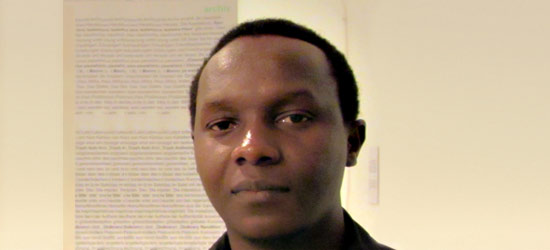Peterson Kamwathi

Peterson Kamwathi (born Kenya, 1980) currently lives and works in Nairobi, Kenya.
He studied at Shang Tao Media Arts College (Nairobi, Kenya) in 2005.
Kamwhati has been awarded numerous artist residencies, including at the Rijksakademie van beeldende kunsten (Amsterdam, the Netherlands) in 2010, Omi International Art Center (New York, USA) in 2009, and at the Bath Spa University (Bath, UK) in 2006.
He was included in DAK’ART 2010, 9th Biennal of Contemporary Art (Dakar, Senegal) in 2010.
Kamwhati has had solo exhibitions at institutions in Africa and North America, including the Goethe-Institut Kenya (Nairobi, Kenya) in 2009, The GoDown Art Centre (Nairobi, Kenya) in 2008, and the Tuska Center for Contemporary Art, Art Department at the University of Kentucky (Lexington, USA) in 2005.
He has also been included in major group exhibitions at the Brot Kunsthalle (Vienna, Austria) in 2010, Ed Cross Fine Art (London, UK) in 2009 and 2010, and at Salena Gallery, Visual Arts Department, University of Long Island Brooklyn Campus (Brooklyn, USA) in 2004.
His work is in major public and private collections, including the collections of the British Museum (London, UK), Robert Devereux (UK), and Robert Loder (UK).
“In my work I have attempted to look at the anatomy and psychology of queues within modern society. Queues, while geared towards circumventing chaos, also emerge as manifestations of social, political, economic and cultural upheavals or shifts.
In 2009 I embarked on a small project aimed at illustrating peace. This was linked to a residency at Art Omi. In this I attempted to come up with what I thought then were universally accepted symbols of peace. In this process I learnt that peace is a state whose identity and form is relative and will vary according to the cultural, political, religious, economic and/or intellectual standpoint of an individual or group.
In this animation I attempt to illustrate the relativity and possible duality of contexts for peace, where the individual has to negotiate with the communal. The setting for both scenes is a street where a person tries to exist in his space notwithstanding the environment. The individual can be anyone in the visually chaotic street.”


